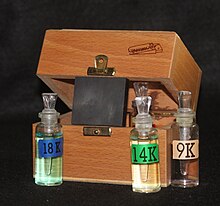Touchstone
A touchstone or touchstone , even sample stone, stone coating, Goldstein or Lydian stone (lapis Lydius) called, is a small muller which to determine the composition and the purity of noble metals is used.
selection
A touchstone must be hard enough to grind and accept a little of the metal to be tested . To make it easier to see the lines left by the abraded metal, it should be black without being dissolved by separating water or aqua regia . These properties are exhibited by black, hard clay stones , such as radiolarite called lydite . A good touchstone is evenly colored deep black or dark red, is also fine-grained, has no stains or other inclusions such as veins. Since the metal lines do not adhere to surfaces that are too smooth, the surface must not be polished , but only sanded matt.
Most probing stones are made of polished black silica slate, the so-called lydite . But colored stones made of black agate are also suitable for this. In contrast, glass or ceramic plates are poorly suited. However, calcareous stone such as marble is completely unsuitable because it is not resistant to nitric acid and foams and froths on contact. - The old touchstone used earlier is said to have been white.
Treatment of the stone
The touchstone must be carefully kept clean. Moistened with water for cleaning, the test lines are removed carefully and without pressing with a pumice stone or fine-grained whetstone so as not to scratch the test stone, otherwise its surface would become unusable. Natural cork is also suitable , with which it is cleaned with water and a non-scratching abrasive . The resulting sludge is rinsed off, then the stone is dried with a soft cloth. Acid is not suitable for cleaning.
A touchstone that was not greased would remove too much material, and the metal lines would only be imperfect and usually difficult to accept. For this reason, the test surface should have a light film of oil or grease . Therefore, the stone is finally covered with thin oil, e.g. B. Almond oil , rubbed in very thinly. (Human skin fat is also suitable.) In the past, it was rubbed with a whole almond kernel or sanded with a soft charcoal. On the other hand, to remove excessive fat, the cleaned stone is placed in a dilute ammonia solution for several hours . Since a dusty stone would not allow a reliable sample, it should be stored dust-free.
use
To determine the degree of purity, the sample is used using a test stone. The test piece (of the presumed precious metal) is rubbed over the test stone in such a way that a metallic line is left behind in order to compare it with the test needle . Touch stones are mainly used by jewelers , goldsmiths and jewelry stores .
Others
In a figurative sense, the phrase "to put to the test" has been an empirical investigation since early modern times , according to which a (theoretical) assumption can be confirmed or rejected; “Then we hold the world in front of a touchstone of god, on which the almighty tries the people, just like a rich man otherwise, and after he has found their value on the line, or after they let themselves be purified by fire, the good and places fine gold and silver medals in his heavenly treasure, but throws the evil and false ones into eternal fire ... ”( Hans Jakob Christoffel von Grimmelshausen : Der adventurliche Simplicissimus , 1668, Fifth Book, Chapter 14).
See also
Individual evidence
- ↑ probing stone, m. . In: Jacob Grimm , Wilhelm Grimm : German Dictionary . Hirzel, Leipzig 1854–1961 ( woerterbuchnetz.de , University of Trier).
- ↑ Carl von Scheuchenstuel : IDIOTICON the Austrian mining and metallurgy language. kk court bookseller Wilhelm Braumüller, Vienna 1856.
- ↑ a b The well-experienced Scheid artist, or practical instruction on how to try and separate all ore and metals, especially gold and silver, with little expense and effort but with great benefit. Frankfurt and Leipzig 1755.
- ↑ a b c d e f Walo Wälchli and Pierre Vuilleumier: The precious metal sample. (last accessed March 12, 2013).
- ↑ a b Mining dictionary. Johann Christoph Stößel, Chemnitz 1778.
- ↑ a b c d Federal Law Gazette for the Republic of Austria. Born 2001, 136th Ordinance: Hallmarking Ordinance ( Memento of May 12, 2013 in the Internet Archive ) (last accessed on March 12, 2013) (PDF; 26 kB).
- ^ Georg Agricola: Twelve books on mining and metallurgy. In commission VDI-Verlag GmbH, Berlin.
